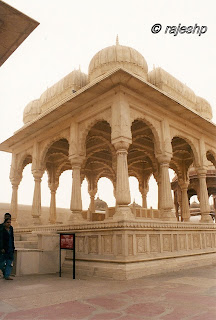After covering all the areas in Jaisalmer we moved out to outskirts of Jaisalmer. Sam village is on the edge of the Desert National Park. One of the most popular excursions is to the sand dunes on the edge of the park, 42 km from Jaisalmer along a very good sealed road.
 It is best to be here at sunrise or sunset, and many camel safaris spend a night at the dunes. Just before the sunset jeep carrying loads of day-trippers arrive from Jaisalmer to be chased across the sands by tenacious camel owners. Despite of the tourist hype, it is still quite a magical place, and it is possible to frame pictures of solitary camels against lonely dunes. The desert dung beetles are fascinating to watch.
It is best to be here at sunrise or sunset, and many camel safaris spend a night at the dunes. Just before the sunset jeep carrying loads of day-trippers arrive from Jaisalmer to be chased across the sands by tenacious camel owners. Despite of the tourist hype, it is still quite a magical place, and it is possible to frame pictures of solitary camels against lonely dunes. The desert dung beetles are fascinating to watch.
From Jaisalmer we traveled to Jodhpur, blue city.
 It is best to be here at sunrise or sunset, and many camel safaris spend a night at the dunes. Just before the sunset jeep carrying loads of day-trippers arrive from Jaisalmer to be chased across the sands by tenacious camel owners. Despite of the tourist hype, it is still quite a magical place, and it is possible to frame pictures of solitary camels against lonely dunes. The desert dung beetles are fascinating to watch.
It is best to be here at sunrise or sunset, and many camel safaris spend a night at the dunes. Just before the sunset jeep carrying loads of day-trippers arrive from Jaisalmer to be chased across the sands by tenacious camel owners. Despite of the tourist hype, it is still quite a magical place, and it is possible to frame pictures of solitary camels against lonely dunes. The desert dung beetles are fascinating to watch.From Jaisalmer we traveled to Jodhpur, blue city.
Distance: Jaisalmer ---> Jodhpur 285 kms
P.S: December is the month when lot of tourists land in Rajasthan. So if you really want all the arrangements to be done properly this has to be done before October end.

















